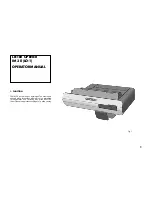
RP0193-2001
8
NACE International
5.2.4 Galvanic current cathodic protection systems
operate on the principle of dissimilar-metals corrosion.
The anode in a galvanic current system must be more
electrochemically active than the structure to be
protected. Cathodic protection using a galvanic system
is afforded by providing an electrical connection
between the anode system and the storage tank
bottom. Typical galvanic current anode materials for
storage tank bottom applications include magnesium
and zinc.
TABLE 1
Cathodic Protection System Characteristics
Galvanic Current
Impressed Current
No external power required
External power required
Fixed, limited driving voltage
Driving voltage can be varied
Limited current
Current can be varied
Satisfies small current requirements
Satisfies high current requirements
Used in lower-resistivity environments
Used in higher-resistivity environments
Usually no stray current interference
Must consider interference with other structures
5.3 In the design of a cathodic protection system, the
following shall be considered:
(a) Recognition of hazardous conditions prevailing at the
site and the selection and specification of materials and
installation practices that ensure safe installation and
operation
(b) Compliance with all applicable governmental codes
and owner requirements
(c) Selection
and
specification
of
materials
and
installation
practices
that
ensure
dependable
and
economic operation of the system throughout its intended
operating life
(d) Design of proposed installation to minimize stray
currents
(e) Avoiding excessive levels of cathodic protection,
which may cause coating disbondment and possible
damage to high-strength and special alloy steels
(f)
If amphoteric metals are involved (i.e., lead, tin,
aluminum), avoiding high or low pH conditions that could
cause corrosion
(g) Presence of secondary containment systems
5.4 Current Requirement
5.4.1 The preferred method of determining the current
requirements for achieving a given level of protection
on an existing tank bottom is to test the tank bottom
using
a
temporary
cathodic
protection
system.
Alternately, a current density can be used for design
purposes based on a current density successfully used
at the same facility or at a facility with similar
characteristics.
5.4.2 For design purposes, current requirements on
new or proposed tank bottoms may be established by
calculating surface areas and applying a protective
current density based on the size of the tank, the
electrochemical characteristics of the environment, the
service temperature, and the parameters of the
groundbed.
Design current densities of 10 to 20
mA/m
2
(1 to 2 mA/ft
2
) of bare tank bottom surface are
generally sufficient.
Systems exposed to chemistry
involving chlorides, sulfides, or bacteria or to elevated
service temperatures require more current. The history
of other tanks in the same environment should be
considered when choosing a design current density.
5.4.3 Care must be exercised to ensure that anode
type and placement result in uniform distribution of
protective current to the tank bottom surfaces.
5.4.4 Liquid levels within tanks must be sufficient to
ensure that the entire tank bottom is in intimate contact
with
an
electrolyte
while
establishing
current
requirements and testing applied protection levels.
Adequate liquid levels are important to maintaining
polarization.
5.4.4.1 As the liquid level increases (and more
of the tank bottom contacts the electrolyte), the
protective current requirement increases and the
potential measured may decrease due to the
increased surface area of steel contacting the
electrolyte.
5.5 Tank System Configuration
5.5.1 Design, materials, and construction procedures
that do not create shielding conditions should be used.
5.5.2 Nonwelded mechanical joints might not be
electrically continuous.
Electrical continuity can be
ensured by bonding existing joints.
5.5.3 If electrical isolation is required, care must be
taken to assure that the isolation is not shorted,
bypassed, etc.
5.6 Special consideration should be given to the presence
of
sulfides,
chlorides,
bacteria,
coatings,
elevated
temperatures,
shielding,
pH
conditions,
treated
tank
padding material, soil/groundwater contamination, dissimilar
metals, and pad/concrete/metal interface at the ringwall, as
well as any heating or refrigeration coils under tank
bottoms. Clean, fine sand is the preferred tank pad material.
Содержание CP 1
Страница 1: ...CP 1 Cathodic Protection Tester Course Manual February 2005 NACE International 2000 ...
Страница 265: ......
Страница 266: ......
Страница 267: ......
Страница 268: ......
Страница 301: ...RP0169 2002 32 NACE International ISBN 1 57590 035 1 ...
Страница 535: ...TM0101 2001 24 NACE International ISBN 1 57590 137 4 ...
















































